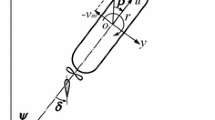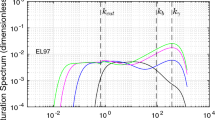Abstract
The methods for direct stability assessment of parametric roll are currently under development at the International Maritime Organization for the second generation intact stability criteria. To establish guidelines for developing accurate, but sufficiently simple prediction method, several elements required for modeling parametric roll in head waves are investigated by executing free running model experiments, partially restrained model experiments with and without surge motion and numerical simulations of uncoupled roll model, coupled surge–roll model and coupled heave–pitch–roll model for a C11 class containership. As a result, the following outcomes are obtained. First, the surge effect on parametric roll is generally small. Second, heave and pitch motions can have subharmonic components when parametric roll occurs. Third, the inclusion of the radiation and diffraction effects on restoring variation can result in more conservative prediction for parametric roll in head seas. Finally, the use of the uncoupled roll model could provide more conservative, but less time-consuming prediction for parametric roll than that of coupled heave–pitch–roll model.














Similar content being viewed by others
References
IMO SDC 1/WP.5 (2014) Development of second generation intact stability criteria. Report of the working group
Munif A, Umeda N (2000) Modeling extreme roll motions and capsizing of a moderate-speed ship in astern waves. J Soc Naval Archit Jpn 187:405–408
Taguchi H, Ishida S, Sawada H, Minami M (1995) Model experiments of ship capsize in Astern Seas. J Soc Naval Archit Jpn 177:207–217
IMO SLF53/INF.10 ANNEX 12 (2010) Replies to comments on draft new generation intact stability criteria proposed by Japan. 142–145
Lu J, Umeda N, Ma K (2010) Modeling parametric roll in regular and irregular head seas with added resistance taken into account. In: Proceedings of the 5th Asia-Pacific workshop on marine hydrodynamics, Osaka Pref Univ, pp 93–98
Umeda N, Hashimoto H, Stern F, Nakamura S, Sadat-Hosseini H, Matsuda A, Carrica P (2008) Comparison study on numerical prediction techniques for parametric roll. In: Proceedings 27th symposium on naval hydrodynamics, Seoul Nat Univ, pp 5–10
Umeda N, Francescutto A (2008) Performance-based ship operation. In: Proceedings 2nd international workshop on risk-based approaches in maritime industry, Univ. Strathclyde, pp 2.2.1–2.2.9
Lu J, Umeda N, Ma K (2011) Predicting parametric roll in irregular head seas with added resistance taken into account. J Mar Sci Technol 16:462–471
Lu J, Gu M, Umeda N (2012) Numerical approaches on parametric roll in Head Seas. In: The 10th international hydrodynamics, Petersburg, Russia, pp 83–88
Rodriguez CA et al. (2007) Validation of a container ship model for parametric roll. In: Proceedings of 9th International Ship Stability Workshop, Hamburg
Neves MAS, Vivanco JEM, Rodriguez CA (2009) Nonlinear dynamics on parametric roll of ship in Head Seas. In: Proceedings of the 10th STAB, pp 509–520
Lu J, Gu M, Umeda N (2013) A Study on the effect of parametric roll on heave and pitch motions in Head Seas. In: Proceedings of the 13th international ship stability workshop, Brest, France, pp 185–191
Hashimoto H, Umeda N (2012) Validation of a numerical simulation model for parametric roll prediction using PCTC. In: Proceedings of the 11th STAB, pp 141–149
Boroday IK (1990) Ship stability in waves: on the problem of righting moment estimations for ships in oblique waves. In: Proceedings of the 4th international conference on stability of ships and ocean vehicles, pp 441–451
Umeda N, Hashimoto H (2006) Recent developments of capsizing prediction techniques of intact ships rerunning in waves. In: Proceedings of the 26th symposium on naval hydrodynamics, Rome, USB
Hashimoto H, Umeda N, Sakamoto G (2007) Head-Sea parametric rolling of a car carrier. In: Proceedings of the 9th international ship stability workshop, Hamburg, pp 4.5.1–4.5.71
Maruo H (1963) Resistance in waves, chap. 5. In: Researches on seakeeping qualities of ships in Japan, Society of Naval Architects Japan 60th Anniversary Ser., no 8, pp 67–102
Fujino M, Sakurai S (1982) On the evaluation of wave exciting roll moment by strip method. J Soc Naval Archit Jpn 152:125–137 (in Japanese)
Lee MC, Kim KH (1982) Prediction of motion of ships in damaged condition in waves. In: Proceedings of the 2nd STAB, the Society of Naval Architects of Japan, pp 13–26
Acknowledgments
A part of this research was supported by the China Scholarship Council [No. 2008606031] for the first author’s visit to Osaka University. The research was supported by the Ministry of Industry and Information Technology of China (No. [2012] 533; No. [2016] 26) and China Research Fund (No. B2420132001; No. 51509124). These supports are gratefully acknowledged.
Author information
Authors and Affiliations
Corresponding author
About this article
Cite this article
Lu, J., Gu, M. & Umeda, N. Experimental and numerical study on several crucial elements for predicting parametric roll in regular head seas. J Mar Sci Technol 22, 25–37 (2017). https://doi.org/10.1007/s00773-016-0391-0
Received:
Accepted:
Published:
Issue Date:
DOI: https://doi.org/10.1007/s00773-016-0391-0




